#dendrobium phalaenopsis
Text
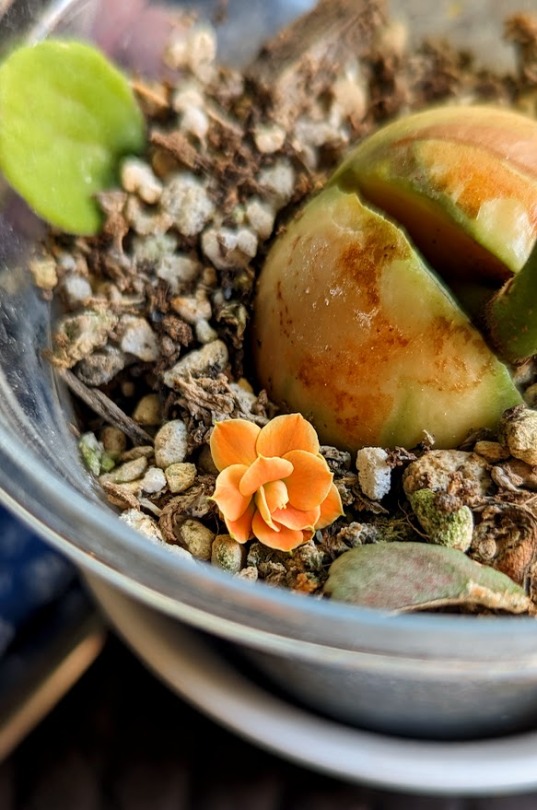
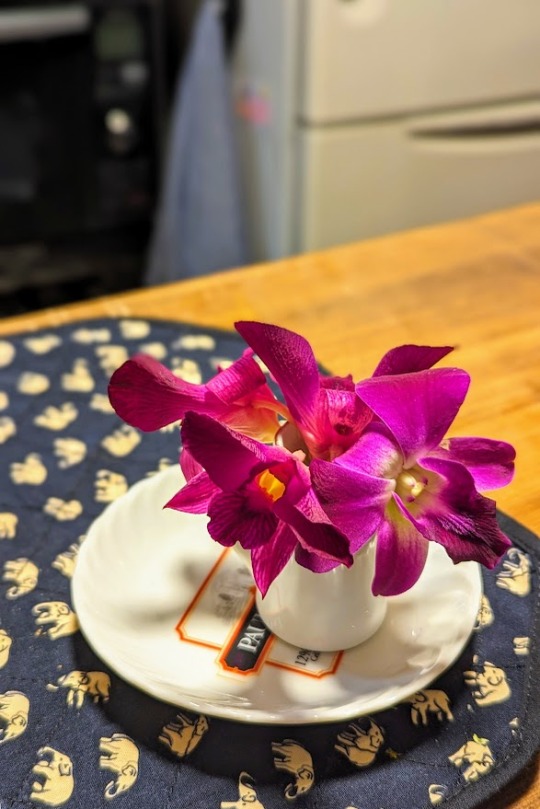
ポロっととれてしまったカランコエの蕾を土に刺すように置いといたら、なんとキレイに咲いてくれました🌼
いつもスーパーで買うデンファレも、落ちた花を挿しておくと、これが結構長持ちするんですよね〜🌹
#flowers#Kalanchoe blossfeldiana#Queen Rose#Dendrobium phalaenopsis#Cooktown Orchid#カランコエ#クィーンローズ#デンファレ#花のある暮らし#三寒四温
69 notes
·
View notes
Video
n136_w1150 by Biodiversity Heritage Library
Via Flickr:
Reichenbachia :. St. Albans [England] :N.Y. [i.e. New York] :F. Sander ;R.B. Young,1892-1894.. biodiversitylibrary.org/page/35543585
#(Heinrich Gustav)#1824-1889#Orchidaceae#Reichenbach#H. G#Missouri Botanical Garden#Peter H. Raven Library#bhl:page=35543585#dc:identifier=http://biodiversitylibrary.org/page/35543585#taxonomy:binomial=Dendrobium phalaenopsis#taxonomy:binomial=Dendrobium bigibbum#Henry Frederick Conrad Sander#orchids#botany#flowers#artist:name=Henry George Moon#artist:viaf=95737474#flickr#Phalaenopsis#dendrobium phalaenopsis#cooktown orchid#Dendrobium bigibbum#mauve butterfly orchid
4 notes
·
View notes
Text


Oh my goodness it was so cool to see all these orchids. Vandas, Dendrobium, oncidiums, Phalaenopsis and ones the owner hybridized herself in laboratory. It was absurdly fun.
#plants#plant#plantblr#succulent#potted plants#houseplants#Spanish moss#moss#carnivorous plants#succulents#cactus#cacti#cacti and desert plants#phalaenopsis#vanda orchid#Dendrobium
71 notes
·
View notes
Text
Next one is my all time favorite, that I've had for 4 years now. She's bloomed every year since then, with more flowers every time.
She's nearly too big for her spot on my bedroom window now, lol.
I don't know her exact name, she was a No ID Orchid at my local plantshop, although I've seen some in online orchidnurserys that look the same.
It's a Phalaenopsis Dendrobium cross, though.
Behold:
(Unfortunately she looks way too red in the video, she's a lot darker than that)





She's already been blooming for over a month now and still looking good!
11 notes
·
View notes
Text

昨年に続き咲いてくれたセロジネのスペシオサさん



なんだか葉っぱが絶好調なナゴラン組と、咲き始めの胡蝶蘭くん(たぶんカララシリーズのグリーンピクシー?)、あと今春に一度咲き終わったと思ったらまた蕾がついてたデンドロさん
2 notes
·
View notes
Text
oh no. oh no. i can feel the autism growing
#its about orchids#i got a phalaenopsis in february and a cattleya last night and im going to buy a dendrobium today ToT#helpppp meeeee
2 notes
·
View notes
Text
What Are Lithophytes?

Originally posted on my website at https://rebeccalexa.com/what-are-lithophytes/
Ask most people what plants need to grow in, and they’ll say “soil” or “dirt”, right? And for the majority of terrestrial plants that’s the case. But given the sheer scale of biodiversity and the ability of species to make use of any niche–no matter how small–left unoccupied, there are of course exceptions. Take epiphytes, for example, that cling to the bark of trees and other plants. Rather than drawing nutrients and water from soil, they instead absorb what they need from the air. Psammophytes also get what they need from the air, but instead sink their root system into shifting sand dunes.
I am especially fascinated by lithophytes. “Litho-” means “stone”, and so a lithophyte is simply a plant that grows on stone. There are two main types of lithophyte. Epilithic lithophytes grow on a stone’s surface, and a crevice in the stone may be populated by endolithic lithophytes. Some of these plants can only grow on stone, so they’re described as obligate lithophytes, but their facultative lithophyte neighbors are those that are able to colonize both stone and soil or another substrate at the same time–some lithophytes can even live as tree-dwelling epiphytes instead!
Like epiphytes, a lithophyte may have some ability to absorb water and nutrients from the air. But they also capitalize on anything that ends up washed into their roots by rain. Endoliths may find that over time debris accumulating in their crevice offers a much-needed resource boost. As part or all of a lithophyte dies, the surrounding plants extract nutrients from the decaying matter–nothing goes to waste in nature, after all. They do not, as a general rule, have a negative effect on the rocks themselves; while some rock-dwelling lichens may chemically weather the stone beneath them, lithophytic plants simply use the rock as a convenient surface to take root.
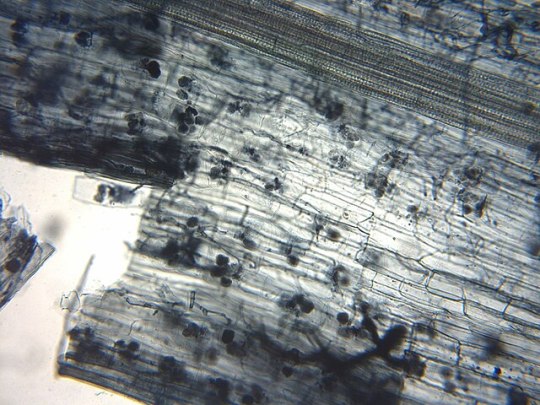
Arbuscular mycorrhizae within a root as seen under a microscope
What I find really cool is that lithophytes can be mycorrhizal! Their roots are pierced by colonies of various arbuscular mycorrhizal fungi that draw up nutrients from the soil and share them with the plants. While this is a very common relationship in nature–four out of every five vascular plant species uses arbuscular mycorrhizal networks–lithophytes seem to have cultivated a greater concentration of these helpful fungi.
A moss-covered rock is often someone’s first encounter with lithophytes. Lacking proper roots, mosses hang onto the stone with tiny rhizomes. Over time they might cover its entire surface, and if said surface is relatively flat and protected from weather and other erosive forces, their decaying remains could be the very beginning of a new patch of soil.
But it’s not just the little bryophytes like mosses that can eke out a living on a rock. More complex vascular plants may also take root on or within stone. One of my favorite ferns, the licorice fern (Polypodium glycyrrhiza) commonly grows as an epiphyte on trees in the Pacific Northwest, but given the right opportunity it will colonize a suitable crevice in a cliff. Orchids may have a reputation for being difficult to care for in captivity, but in the wild there are a lot of lithophytic species. Many, like Dendrobium teretifolium or many Phalaenopsis species, can also live quite well as epiphytes on a tree or other plant. And the wallflower, Erysimum cheiri, got its common name for its tendency to grow out of cracks in rocky slopes.

Nepenthes campanulata
Unsurprisingly, some carnivorous plants make their homes on rocks, and their carnivory allows them access to much-needed nutrients in an otherwise limited setting. The pitcher plant Nepenthes campanulata often grows in colonies on cliff faces. Heliamphora exappendiculata, another pitcher plant, will happily grow both in wetlands and on constantly damp rocks. Sanderson’s bladderwort (Utricularia sandersonii) doesn’t eat insects, but instead sucks up microscopic organisms using bladders the plant buries under nearby soil or sediment.
One more thing: are the plants you see growing in gravel also lithophytes? Not necessarily. There may be soil beneath the gravel that the plant is exploiting. Or the gravel itself may be part of a mineral soil–one that has a lot of stone and not much organic material. A true lithophyte is going to be attached to a rock or rooted in its crevice, though it’s possible to find lithophytes growing on stones that, through weathering, may be feeding fragments into a nearby mineral soil over time.
Did you enjoy this post? Consider taking one of my online foraging and natural history classes or hiring me for a guided nature tour, checking out my other articles, or picking up a paperback or ebook I’ve written! You can even buy me a coffee here!
#lithophytes#botany#plants#science#nature#scicomm#carnivorous plants#moss#fungi#mycorrhizal fungi#mycology#ecology#bryophytes#biodiversity#epiphytes#educational
121 notes
·
View notes
Note
Since you've gifted with so many orchid rambles, I've decided asking you will be a lot more fun thank asking Google lol
Are orchids difficult to take care of? :0 they've got a reputation for being a very persnickety plant, but I've heard somewhere that stores often put awful/incorrect instructions for how to take care of them, so their difficulty may not ~actually~ be their fault. Thoughts? 🤔
Hahaha, I fully support asking me over Google!! I've gotten a lot of my orchid information from various direct sources (feat. my mom, Aislin, Reddit, and MissOrchidGirl on YouTube) because you are extremely correct: the information that most shops give, especially grocery store orchid labels, is wildly inaccurate!
Personally, I find your usual grocery store phalaenopsis orchids to be one of the easiest plants to take care of, and also that they're bred to bloom repeatedly and prolifically. I have a grocery store orchid that's been holding onto the same flowers for nine months, which is abjectly ridiculous. My grocery store phals will bloom twice a year and typically hold blooms for 3-6 months. At long as you set them up correctly, they're very low maintenance!
The main thing is that while they're easy plants, they are also different from the houseplants that most people are used to and that's what trips people up. For example: they're epiphytes so you can't plant them in soil, it will eventually kill them! You also should not water them with ice cubes like some labels advise: they are tropical plants that don't appreciate a shock of cold water, and it's often not enough water. The other thing is that most orchids bought from grocery or big box stores are not set up/potted for success in a home environment. A lot of people bring orchids home only for them to die soon after, and it's often due to the conditions they bought the orchid in (or, uh, occasionally, thinking that the flowers fading is the same as the whole plant dying).
The basic three fundamentals of keeping orchids I like to espouse:
Repot them into a fresh orchid bark mix and a clear orchid pot with slotted sides (you can then put this in a prettier cache pot like I do) within a month of acquisition. This way you know they're not drowning in pure sphagnum moss, old seedling dirt plugs, or decomposing old bark, all of which may cause root rot and kill the plant. Repot once every 1-2 years. Here's a good video on it!
Water them by soaking the whole pot in room temperature water for 15 minutes or so. You know they're ready for water when the potted roots turn silvery rather than vibrant green (this is where the clear pot comes in handy), but usually about once a week is also good! You may also add orchid fertilizer into this water for greater success in growth and blooming.
Put them somewhere bright without direct afternoon sunlight. A north window that gets bright indirect light, or an east window that gets some morning sunlight. Harsh afternoon sunlight may burn them, but they do enjoy a lot of light when possible.
And that's it! Just the correct amount of light, water about once a week, and putting them in a better potting mix than what they came in. You can get more involved than that if you want, but for the average person I think this is really what it comes down it.
Now, I have more orchids than just phalaenopsis orchids (I have two oncidiums, one dendrobium nobile, one cattleya, and three phalaenopsis hybrids) that can require slightly different care, so if you get something different from the standard "moth orchid," it's a good idea to look up specific care requirements. But phals are generally really easy in my personal opinion!
19 notes
·
View notes
Text


Die Queensland-Orchidee (Dendrobium phalaenopsis)
#photograph#photographers#deutschland#beautiful#natur#nature#photographer#fotografie#photography#natural#hannover#botanic#botanical#herrenhausen#orchid#orchids#orchidee#orchideen#tropic#tropical#jungle
23 notes
·
View notes
Text

proud of my splatoon shrine hehe
highlight: you can hover over the favorite items to bring up a preview of the item!

edit: moved some pages around, so i had to update the link ^
16 notes
·
View notes
Text
Orchid Corner
Botanical species and low-gen hybrids currently in bloom (as depicted in phone snapshots, because I’m too dead to get my camera right now):
Brassolaelia Yellow Bird (Brassavola nodosa x Brassocattleya Richard Mueller (Brassavola nodosa x Cattleya milleri))

Phalaenopsis equestris

Dendrobium nobile

And as always a bunch of unnamed generic Phalaenopsis hybrids:




22 notes
·
View notes
Video
n34_w1150 by Biodiversity Heritage Library
Via Flickr:
The floral magazine; London,L. Reeve & Co. biodiversitylibrary.org/page/46013282
#Flower gardening#Flowers#Periodicals#Pictorial works#Smithsonian Libraries#bhl:page=46013282#dc:identifier=https://biodiversitylibrary.org/page/46013282#plant#flower#Phalaenopsis#bellina#flickr#dendrobium phalaenopsis
0 notes
Photo



did this set of orchids (from left: phalaenopsis, dendrobium, cymbidium) for my dear friend @virgoandvines ! :D
please reblog if you enjoy <3
26 notes
·
View notes
Text

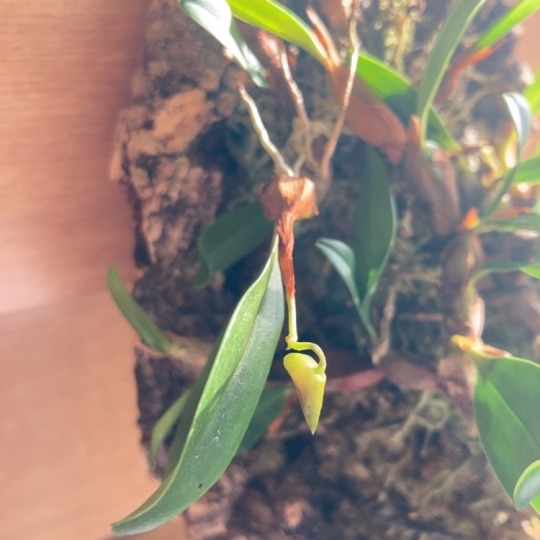
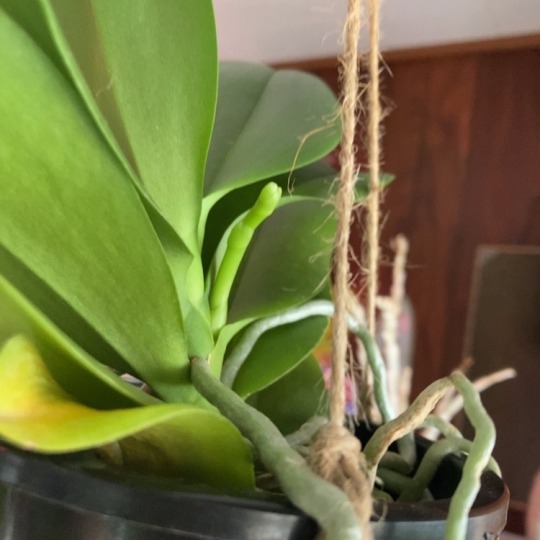

葉脈が綺麗だなと思ったビカクシダ
デンドロビューム(エピゲニューム)・ナカハラエの蕾
伸びてきた胡蝶蘭の花芽
一輪咲いたセロジネ・アッサミカ
2 notes
·
View notes
Text
4 notes
·
View notes
Text
Descubra a Espécie de Orquídea Mais Rara do Mundo - Paphiopedilum sanderianum

As orquídeas são verdadeiras maravilhas da natureza, destacando-se pela sua extraordinária beleza e pela complexidade das suas formas e cores. Com mais de 25.000 espécies conhecidas, cada uma possui características únicas.
No entanto, entre essa vasta diversidade, uma espécie se destaca pela sua raridade extrema e pelos desafios que enfrenta: a Paphiopedilum sanderianum, também conhecida como "Sapatinho de Senhora" ou "Lady's Slipper".
Neste artigo, vamos explorar a origem, as características, os cuidados especiais e as questões de conservação desta orquídea única, além de mencionar outras espécies notáveis do fascinante mundo das orquídeas.
Origem e Características da Paphiopedilum sanderianum
A Paphiopedilum sanderianum é originária das florestas tropicais do sudeste asiático, especialmente das Filipinas. Esta orquídea é uma verdadeira jóia botânica, famosa pelo seu formato distinto e pela sua raridade. A sua aparência é uma das mais icónicas entre as orquídeas: as suas flores possuem uma estrutura que lembra um pequeno sapatinho ou chinelo, com pétalas que se estendem de forma graciosa e delicada.
As flores da Paphiopedilum sanderianum apresentam uma combinação de cores exuberantes, que vão desde tons de verde pálido até castanho, frequentemente com manchas ou listras. As pétalas laterais são bastante longas e curvadas, o que contribui para a sua aparência elegante e única.
O labelo (a parte inferior da flor) é amplamente expandido e possui uma forma que se assemelha a um pequeno saco, daí o nome "Sapatinho de Senhora". Esta estrutura não só é bela, mas também desempenha um papel crucial na atração de polinizadores específicos, como certas espécies de abelhas e moscas.
Outras Espécies Notáveis de Orquídeas
Embora a Paphiopedilum sanderianum seja uma das orquídeas mais raras, existem muitas outras espécies notáveis que merecem destaque.

Phalaenopsis - Também conhecida como a "Orquídea Moth", a Phalaenopsis é uma das orquídeas mais populares e amplamente cultivadas. Suas flores são grandes e apresentam uma ampla gama de cores, incluindo rosa, branco e amarelo. É uma espécie relativamente fácil de cuidar, tornando-a ideal para iniciantes.

Vanda - As orquídeas Vanda são apreciadas por suas flores grandes e brilhantes, que podem ser encontradas em tons de azul, roxo, rosa e vermelho. Estas orquídeas são conhecidas pelas suas raízes aéreas e por exigir uma alta humidade para prosperar.

Cattleya - Conhecida como a "Rainha das Orquídeas", a Cattleya é famosa pelas suas flores grandes e vibrantes. Estas orquídeas são frequentemente usadas em arranjos florais devido à sua beleza impressionante e ao seu aroma doce.

Dendrobium - Este género de orquídeas inclui várias espécies, que variam em tamanho e forma. As Dendrobiums são apreciadas pelas suas flores em forma de estrela e pela sua capacidade de florescer em diferentes épocas do ano. São nativas de várias regiões da Ásia, incluindo Austrália e Indonésia.

Oncidium - Popularmente conhecida como "Dança das Abelhas" devido ao formato das suas flores que se assemelham a pequenas abelhas, a Oncidium é uma orquídea que pode ter uma floração abundante e duradoura. Suas flores são pequenas e numerosas, apresentando uma grande variedade de cores e padrões.
Cuidados Especiais para Cultivo
Cultivar a Paphiopedilum sanderianum pode ser um desafio, principalmente devido à sua raridade e às condições específicas que requer para prosperar.
Se está a considerar adicionar esta orquídea única à sua coleção, é importante estar ciente das suas necessidades especiais.
https://youtu.be/jhWRV5VuY9g?si=YjPWNy-htGUn1kai
Aqui estão algumas diretrizes essenciais para garantir que a sua orquídea se desenvolva da melhor forma possível:
- Iluminação: Esta orquídea prefere luz filtrada e indireta. No seu habitat natural, cresce sob a sombra de outras plantas, por isso, ao cultivá-la em casa, deve evitar a exposição direta ao sol, que pode queimar as folhas e prejudicar o desenvolvimento da planta. Um local ideal pode ser perto de uma janela voltada para o leste ou o oeste, onde a luz solar é suave e filtrada.
- Humidade: A Paphiopedilum sanderianum requer um ambiente com alta humidade. Na sua região natural, a humidade pode ser superior a 60%. Para replicar essas condições em casa, pode utilizar um humidificador ou colocar a planta sobre uma bandeja com pedras e água, garantindo que o fundo do vaso não fique submerso na água. A humidade é essencial para a saúde da planta e para a prevenção de doenças fúngicas e bacterianas.
- Substrato: A escolha do substrato é crucial para o cultivo bem-sucedido desta espécie. Um substrato bem drenado e aerado é fundamental para evitar o apodrecimento das raízes. Uma mistura recomendada pode incluir casca de pinheiro, carvão vegetal e musgo Sphagnum (esfagno). Este tipo de substrato permite uma boa circulação de ar e drena o excesso de água, ajudando a manter as raízes saudáveis.
- Temperatura: A temperatura ideal para a Paphiopedilum sanderianum varia entre 18 e 24ºC. Ela tolera variações moderadas, mas mudanças bruscas de temperatura podem ser prejudiciais. Deve evitar expor a planta a temperaturas abaixo de 15ºC, especialmente durante a noite.
- Rega: A rega deve ser regular, mas é importante evitar encharcar o substrato. A orquídea deve ser regada quando a camada superior do substrato estiver seca ao toque. É preferível utilizar água destilada ou água de chuva, uma vez que a água da torneira pode conter químicos que podem prejudicar a planta. Além disso, evite molhar as folhas diretamente para prevenir o aparecimento de manchas ou doenças.
- Fertilização: Para promover um crescimento saudável e uma floração exuberante, a Paphiopedilum sanderianum deve ser fertilizada regularmente. Use um fertilizante equilibrado, diluído a metade da concentração recomendada, e aplique uma vez por mês durante o período de crescimento ativo (primavera e verão). Durante o outono e inverno, a fertilização pode ser reduzida ou interrompida.

Conservação e Preservação
A Paphiopedilum sanderianum enfrenta vários desafios de conservação. A sua raridade e a destruição do seu habitat natural são ameaças significativas. A coleta ilegal de orquídeas selvagens também contribui para a sua diminuição na natureza. Muitas vezes, essas plantas são retiradas das florestas para o comércio de colecionadores, o que prejudica ainda mais as populações naturais.
Para ajudar a conservar esta espécie rara, é importante apoiar práticas de cultivo responsáveis e iniciativas de preservação. Participar em projetos de conservação e promover a consciencialização sobre a importância da proteção dos habitats naturais são passos cruciais. Além disso, adquirir orquídeas de fontes confiáveis e legais, que garantem que as plantas foram cultivadas de forma sustentável, também contribui para a proteção desta espécie.
Conclusão
A Paphiopedilum sanderianum é uma das orquídeas mais raras e impressionantes do mundo, encantando com a sua beleza única e desafiando os cultivadores com as suas necessidades específicas. O cultivo bem-sucedido desta espécie exige atenção e cuidados detalhados, mas o resultado é uma planta verdadeiramente espetacular.
A conservação desta orquídea é igualmente importante, e cada um de nós pode contribuir para garantir que as futuras gerações possam desfrutar desta maravilha botânica. Com o devido respeito pelas suas necessidades e um compromisso com a proteção do meio ambiente, podemos ajudar a preservar a Paphiopedilum sanderianum e a riqueza da biodiversidade que ela representa.
Read the full article
0 notes

